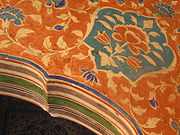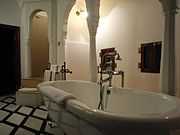Samode Palace
| Samode Palace ( Mahar Kalan) | |
|---|---|
 Samode Palace Lounge | |
 | |
| General information | |
| Architectural style | Rajput and Mughal Architecture |
| Town or city | Samode, Mahar Kalan and Jaipur |
| Country | India |
| Coordinates | 27°12′18″N 75°48′20″E / 27.205°N 75.8055°E |
| Completed | 16th century |
| Client | Rawals |
| Technical details | |
| Structural system | Marble and masonry |
| Design and construction | |
| Architect | Rawal Berisal |

Samode Palace, Samode Haveli and Samode Bagh (Garden) are heritage monuments and structures built by the noble feudatory with the hereditary title of 'Maha Rawal' or 'Maha Saheb’ of the Amber and Jaipur principality in Rajasthan, India. All three have rich history of several hundred years and display a fusion of Mughal and Rajasthani art and architecture. They are now part of the Heritage group of hotels under the flagship name of “Samode” that are run by the hereditary owners of these structures. The Samode Palace is located 40 kilometres (25 mi) north of Jaipur city, the Samode Haveli is close to Jaipur (centrally located within city limits, 6 kilometres (3.7 mi) away from the city railway station) and the Samode Bagh or Garden, 4 kilometres (2.5 mi) from the palace which is also run as a luxury hotel.[1][2]
Many Hindi feature films have been pictured with the settings of the palace. The 1984 American HBO TV serial adaptation of the Raj-romance novel The Far Pavilions was also filmed in the palace precincts and starred Ben Cross, Amy Irving, Omar Sharif and Christopher Lee.[2][3][4]
History
Samode is a large town in Rajasthan, which belonged to the landlords known as ‘zamindars’ (in Hindi language) of the principal thakurs of the state of Amber. It shot into prominence due to the thakurs lineage traced to Maharaja Rajveer Singhji, the 17th prince of the house of Kacchwaha Rajputs. Samode was bequeathed to Gopal Singhji one of his 12 sons, as a noble feudatory of the Amber and Jaipur principality. Samode was, even then, considered a very rich town under the kingdom of Amber. Behari Das, a Rajput warrior who was then in Mughal service of the Nathawat clan inherited the Zamindari of Somede. It was under the British Raj but was restored to the Nathawat clan with the hereditary title 'Rawal Saheb' or 'Maha Rawal' (title conferred for their valiance and loyalty to the royal family), in 1757, and this lineage is continued to this date.[5][6]
Samode Palace was initially built in the sixteenth century as a Rajput fort, but in early 19th century, under the nobleman Rawal Berisal, it was converted from a fort into an exquisitely designed palace in Rajput and Muslim architectural style. Rawal Berisal, during this time also served as the Chief Minister of Rajasthan and exercised full powers. He was signatory, on behalf of the Maharaja of Jaipur, to the treaty signed in 1818 with the British East India Company, which gave it the status of a protectorate to Jaipur. Rawal Sheo Singh, descendent of Rawal Berisal, who was the Prime Minister of Jaipur state for several years, during the middle of the 19th century, further expanded the Palace by adding the Darbar Hall (considered as "extravagantly florid and hand painted") with a gallery and the Sheesh Mahal or the hall of mirrors. In 1987, it was converted into the heritage “Samode Palace Hotel”.[5]
Samode haveli was also built by Rawal Sheo Singh more than 150 years ago. It was built as a resort for the royal family.[7]
Samode Bagh or Samode garden was landscaped more than 150 years ago by one of the sons of Maharaja Prithiraj Singhji of Jaipur. It was patterned on the lines of Mughal gardens, which the Mughals had developed in other parts of their kingdom as a retreat for relaxation and enjoyment. The royal family of Samode also established a similar garden 4 kilometres away from their Samode Palace.[1]
Geography and climate
Geographically, the three monuments and the village of Samode and its structures are in the pristine hill range of the Aravalli Range in north-western India.[8]
The climate at Samode is severe with summer heat reaching as high as 45 °C (113 °F) and winter temperatures dropping to 4 °C (39 °F).[6]
Structures
The three heritage structures are:
Samode palace


The palace, built by the noblemen of the court of the royal family, is located near the Samode village on the outskirts of Shekhawat. It is built of sandstone at the foot of the Aravalli range of hills (the foremost mountain range of north-western India) with a fortress like setting. The interiors of the palace are composed in the ancient architectural style of Rajasthan: marble floors, intricately ornamented pillars, mosaic walls (with tiny pieces of small inlaid stones), with luxurious carpets, and decorated with old wall paintings (hunting scenes, floral motifs and so forth). At the entrance gate of the palace is a unique piece of a large sized treasure chest made of dark wood with marble settings and gleaming glass. The Sheesh Mahal (Hall of Mirrors) is located on the southern side of the palace.[3][9] The frescoes in the Durbar hall and in the Sultan Mahal are said to be 250 years old.[2] The palace is built on three levels (planned in a sequence of courtyards of increasing height) with a patio on each floor. There is an old ruined fort above the palace from where a panoramic view of the valley could be seen. The fort area is overgrown with vegetation but stone paved paths have been built to reach the fort heights.[5][10] Samode fort was the former residence of the Maharaja. It is said that an underground passage links it to the palace that provided access at times of emergency. It is now approached by a well laid out stone paved path (300 steps). There is also an entry gate to the ruined fort. Two other forts close by complete the circuit of a circular walk from and back to the palace. There is also a small temple, 3 kilometres away from the fort.[3][11]
The Samode village near the palace is noted for its cloth made by block printing and also for handicrafts such as bangle making.[3] There is a small artists' colony in the village where miniature paintings are made.[8]
Samode haveli


The haveli is built facing north. It has an elegant painted dining room and an airy passage. It has a unique ambiance of the historic juxtaposed against a contemporary setting. An elephant ramp, specially constructed at the entrance to the haveli, was laid in 1940 on the occasion of the marriage ceremony of a member of the Royal family.[7]
Samode bagh
Samode Bagh, Mahar kalan or garden, a 16th-century Mughal style garden, enclosed by a 15 feet (4.6 m) high wall is spread over an area of 20 acres (8.1 ha). It also has 44 sandbank coloured tents with air-conditioning to accommodate visitors. It blends traditional Rajasthan and Mughal décor with the Victorian style, with modern facilities. It has a 200 feet (61 m) long water channel with a row of fountains that are fed by springs and wells. The tent walls also depict elegant paintings in Mughal art. The tents have been furnished with carpets, standing lamps and well designed beds and chairs and other modern facilities.[1][2][12] There is also a 150 year old pavilion within the precincts of the garden.[10][11]
Visitor information
The palace, the haveli and the garden are at a distance of 42 kilometres (26 mi), 6 kilometres (3.7 mi) and 45 kilometres (28 mi) respectively from Jaipur. Jaipur in turn is well connected by rail, road and air to all the major cities in the country. Jaipur is 260 kilometres (160 mi) from Delhi by road on the National Highway NH-1
Entry to the palace is not free and costs Rs 500 per person as on Feb 2011. This includes the Bagh & the Palace.The only things that you can access in Samode Palace if you have not checked in( its used as a hotel) is the sish mahal(room of mirrors) and the darbur hall. If you have visited Amber Fort then you have wittnessed a better shish mahal and darbur. You need your own transport to visit samode. The Bagh is nice but again its too a resort which provides tent houses. If you are not a guest and just a visitor, you will need a ticket of Rs.500/-(a combo for both Bagh & Palace). Before heading for Samode please inform yourself on the prevailing entry fee rate from Jaipur.
Notes
- ↑ 1.0 1.1 1.2 "Samode Bagh". Retrieved 2009-12-05.
- ↑ 2.0 2.1 2.2 2.3 Bruyn, Pippa de; Keith Bain, Niloufer Venkatraman and Shonar Joshi (2008). "Frommer's India". Samode Palace (Frommer's). pp. 412–13. ISBN 0-470-16908-7. Retrieved 2009-12-05.
- ↑ 3.0 3.1 3.2 3.3 Abram, David (2003). "Rough guide to India". Samode (Rough Guides). p. 161. ISBN 1-84353-089-9. Retrieved 2009-12-05.
- ↑ The Far Pavilions on imdb.com
- ↑ 5.0 5.1 5.2 "History, Location & Map". Samode Palace. Retrieved 2009-12-05.
- ↑ 6.0 6.1 "About Samode". Retrieved 2009-12-05.
- ↑ 7.0 7.1 "History, Location and Map". Retrieved 2009-12-05.
- ↑ 8.0 8.1 Bradnock, Roma (2001). "Rajasthan & Gujarat handbook: The Travel Guide". Samode (Footprint Travel Guides). pp. 134–5. ISBN 90094992X Check
|isbn=value (help). - ↑ Reiter, Christiane; Angelika Taschen (2004). "The hotel book: great escapes Asia". A Giant treasure Chest (Taschen). p. 53. ISBN 3-8228-1913-1. Retrieved 2009-12-05.
- ↑ 10.0 10.1 Brown, Lindsay; Amelia Thomas (2008). "Rajasthan, Delhi and Agra". Samode (Lonely Planet). pp. 180–181. ISBN 1-74104-690-4. Retrieved 2009-12-05.
- ↑ 11.0 11.1 Stott, David (2007). "Footprint Rajasthan". Samode (Footprint Travel Guides). pp. 146–47. ISBN 1-906098-07-7. Retrieved 2009-12-05.
- ↑ "Samode Bagh". Tents. Retrieved 2009-12-05.
References
| Wikimedia Commons has media related to Samode Palace. |
- Abram, David (2003). Rough guide to India. Rough Guides. p. 1404. ISBN 1-84353-089-9.
- Bradnock, Roma (2001). Rajasthan & Gujarat handbook: The Travel Guide. Footprint Travel Guides. p. 464. ISBN 90094992X Check
|isbn=value (help). - Brown, Lindsay; Amelia Thomas (2008). "Rajasthan, Delhi and Agra". Samode (Lonely Planet). pp. 180–181. ISBN 1-74104-690-4. Retrieved 2009-12-05.
- Bruyn, Pippa de; Keith Bain, Niloufer Venkatraman and Shonar Joshi (2008). "Frommer's India". Samode Palace (Frommer's). pp. 412–13. ISBN 0-470-16908-7. Retrieved 2009-12-05.
- Reiter, Christiane; Angelika Taschen (2004). The hotel book: great escapes Asia. Taschen. p. 400. ISBN 3-8228-1913-1.
- Stott, David (2007). "Footprint Rajasthan". Samode (Footprint Travel Guides). pp. 146–47. ISBN 1-906098-07-7. Retrieved 2009-12-05.